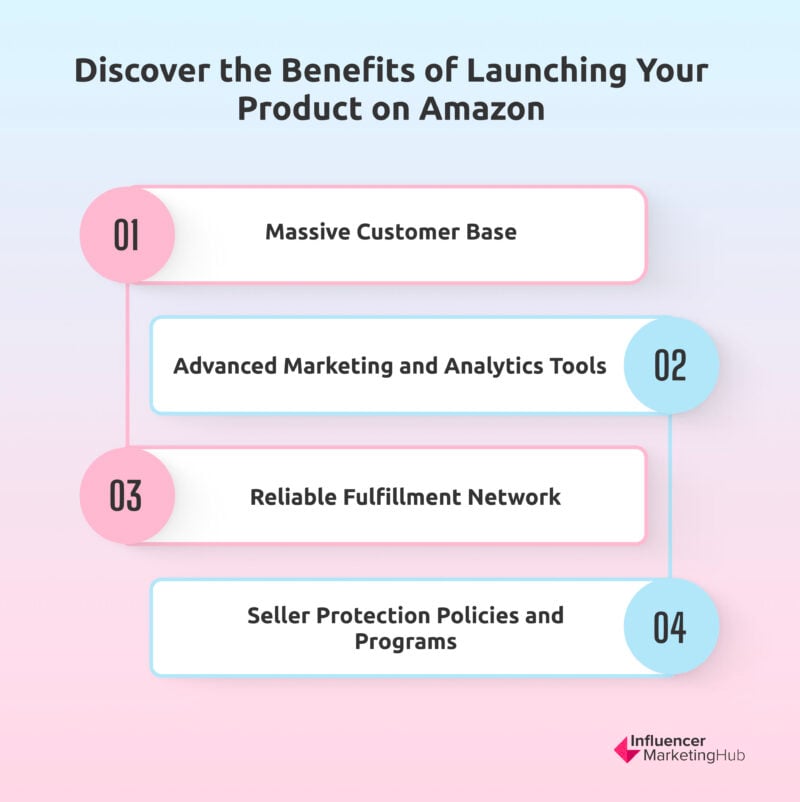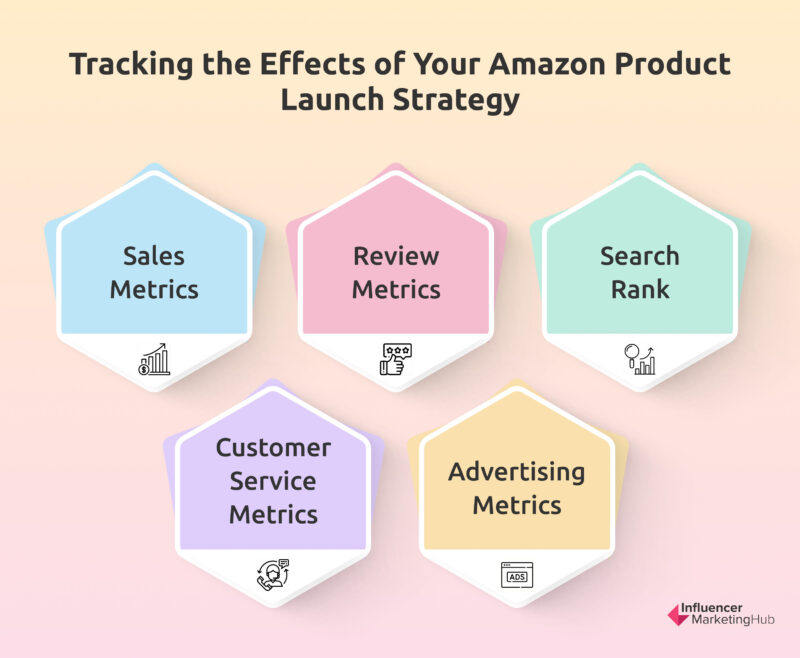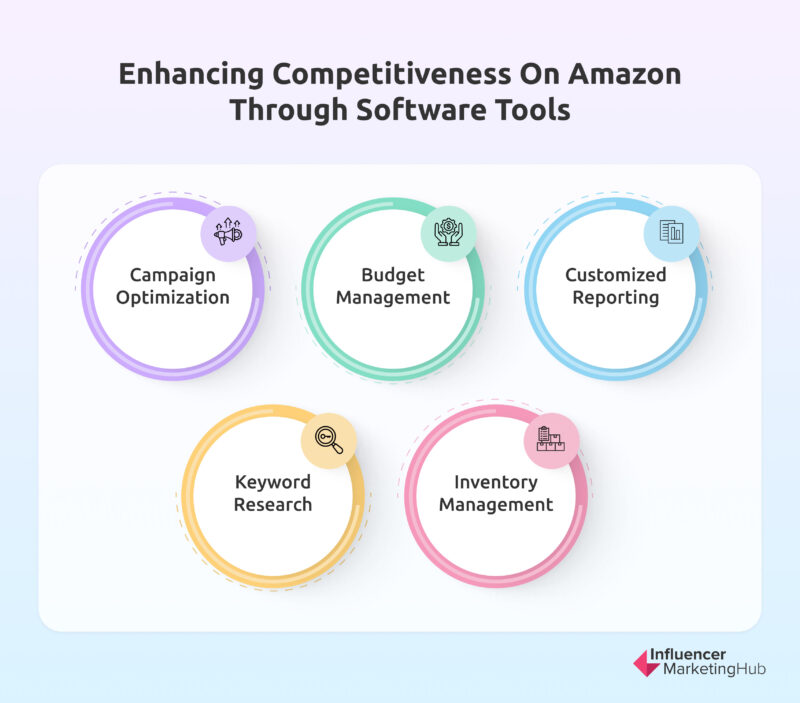Amazon is a complex and ever-changing marketplace. Trends and algorithms shift constantly, and the competition is fierce. Yet, despite these obstacles, there are sellers who’ve launched new products on Amazon successfully.
So, what are the Amazon marketing strategies that have succeeded? We’ve broken down Amazon product launches into six steps. With the following practical steps, you can improve product visibility and achieve successful sales outcomes.
Why Should You Launch a Product on Amazon?
Launching a product on Amazon offers a wide range of benefits for new and experienced sellers that can set them up for success. One of the main advantages is the platform's massive customer base.
Amazon provides access to a vast audience globally that is actively looking to make purchases. This is especially valuable for new sellers who may not have an established customer base or brand recognition.
Additionally, Amazon's fulfillment network can help streamline your logistics and shipping processes, saving you time and money. By using Amazon's fulfilment service, you can focus on other aspects of your business, such as product development, marketing, and customer service. Here is a breakdown of the benefits:
Massive Customer Base:
- Access to over 300 million active users.
- Valuable for new sellers without an established customer base or brand recognition.
Advanced Marketing and Analytics Tools:
- Sponsored Products ads to promote products to shoppers actively searching for related items.
- Detailed analytics and data insights to identify trends and opportunities within the market.
Reliable Fulfillment Network:
- Advanced logistics and shipping capabilities.
- More efficient and reliable customer experience.
- Reduction in costs.
Seller Protection Policies and Programs:
- Protection against fraud and other risks.
- Increased seller trust in the platform.
The Challenge of Amazon Product Launches
It's very simple. For your product to be sold, it needs reach.
In order to gain traction on your product's reach, you need to rank high. And, in order to rank high, it needs to sell.
The question is, where do you start? How do you create the famous Amazon Flywheel effect that everyone is talking about?
Many new businesses that want to gain traction on highly competitive niches within Amazon simply have to work on a short-term pricing strategy that will make their product more competitive pricing-wise. Does this mean you have to potentially operate at a loss?
The simple answer is, yes. It's a must to generate the first few sales and motivate your customers to leave outstanding reviews.
In addition to the complex challenge of Amazon pricing strategies, there are a number of other hurdles that sellers will need to understand so that they can devise an effective strategy like:
1. Keyword Difficulty
With millions of products available on Amazon, it can be challenging to get your product in front of potential customers. To gain traction, your product needs to rank high in Amazon search results, but to rank high, it needs to sell. It's a classic chicken-and-egg situation. To break through, you need to create the famous Amazon Flywheel effect, which is a cycle of customer engagement that leads to more sales and better visibility.
Put simply, keyword difficulty refers to how hard it is to rank for a specific keyword. High difficulty means more competition, often from well-established sellers. Low difficulty suggests fewer sellers are vying for attention.
To help you overcome the challenge of keyword difficulty, you can use tools for thorough keyword research and competitor analysis. You can, for example, check out:
These tools will help you to identify high-volume and relevant keywords which you can incorporate into your product listing. It will also help you to understand your competition and identify opportunities to differentiate your product by, for example, using keywords that they’re targeting ineffectively.
2. Heavy Competition
In highly competitive niches, many new businesses have to work on a short-term pricing strategy that will make their product more competitive pricing-wise. However, this is not a sustainable strategy in the long run, and businesses need to find ways to balance pricing competitiveness with profitability.
3. Constant Changes
Amazon is a highly dynamic marketplace, and businesses need to be prepared to adapt to changes quickly. This includes being aware of changes to Amazon's terms of service and policies, which can impact your product listings and visibility. Moreover, businesses need to monitor their competition and adjust their strategies accordingly, which can require significant resources and expertise.
4. Understanding the Algorithm
Adding to the previous challenge, there’s the pressure of understanding Amazon’s algorithm, which it also continuously refines. You need to identify ways that you can use factors like relevance, customer satisfaction and competitive pricing which can have a significant influence on your search rankings in your favor.
The following product launch best practices will help you to leverage the algorithm:
- Do thorough keyword research using the tools mentioned earlier and optimize your product listing (this is also the first step of a successful product launch—more about this later)
- After offering an introductory discount to attract early buyers and generate initial traction, continue to research your competitors to set a competitive price point
- Provide excellent customer service and send follow-up emails to encourage positive reviews
- Create paid ads that start with broad match campaigns using your main keywords to gather data and then refine your strategy by targeting high-converting keywords
- Continuously monitor your product's performance metrics (such as click-through rates, conversion rates, and sales) and adjust your strategies based on data-driven insights
Amazon Product Launch Strategy
The Amazon marketplace is no exception to the dominance of multinational corporations. However, smaller sellers still have a fighting chance. One of the key advantages that smaller sellers have is their agility and ability to pivot quickly. By keeping a close eye on the competition and identifying gaps in the market, smaller sellers can quickly develop and launch new products that meet the needs of their customers.
In fact, Amazon's platform provides smaller sellers with a unique opportunity to compete with larger corporations. The platform's powerful marketing tools, such as Sponsored Products ads and Amazon Product Targeting, can help smaller sellers reach their target audiences and stand out in a sea of products. By focusing on niche markets and offering unique products and value propositions, smaller sellers can carve out a loyal customer base that is passionate about their brand.
Additionally, Amazon's fulfillment network can help level the playing field for smaller sellers. By using Amazon's fulfillment service, sellers can take advantage of the platform's advanced logistics and shipping capabilities. This can help streamline their operations and reduce costs, while also provides a more efficient and reliable customer experience.
Let's dig into fundamentals you simply need to master in order to gain traction:
Step 1: Setting goals and budgeting
As with virtually any business undertaking, the first step is to define your target audience. It’s more than simply saying parents, for example.
Who will most likely be interested in and benefit from your new product? Use factors like demographics, needs, and interests and identify a specific group of Amazon buyers.
In addition to knowing your audience, you also need to have a clear understanding of what you want to achieve. For example, how many units do you aim to sell in the first month, quarter, and year?
Also set goals for customer reviews and ratings. As mentioned earlier, customer satisfaction and net promoter scores are important key performance indicators (KPIs) that can be dealbreakers when selling on Amazon.
To help you achieve these goals, establish a timeline for pre-launch, launch, and post-launch activities. For example, pre-launch activities that you’ll need to complete before you can set up your ad campaigns include competitor analysis, branding, and product listing optimization. As most of these activities will have a knock-on effect on other steps, it’s essential to know what needs to happen when to keep your product launch on track.
You’ll also need to plan beforehand how you’ll allocate your resources. Expenses that you’ll need to cover include:
- Product development which includes raw materials, packaging and funds for testing and quality assurance
- Advertising and marketing
- Logistics and fulfillment
Be prepared to adjust your goals and budget based on market conditions and performance data.
Step 2: Optimize your Amazon listing
As mentioned earlier, keyword difficulty is one of the challenges of a product launch strategy. To overcome this hurdle, you’ll need to optimize your Amazon listing.
It starts with the product title. It needs to be informative, yet engaging. You can use the following formula to ensure that you cover everything without exceeding the word limit:
Brand Name + Main Keyword + Key Features + Benefits
You can showcase your features and benefits in greater detail when you write your product description. Tie the features to consumer needs and paint points using bullet points for easy readability. Also, ensure that you include long-tail keywords to improve visibility.
Then, leverage A+ Content and add high-quality images and infographics to enhance your product detail pages.
For Elias Rima, founder at 1LEAP, high-resolution images along with keywords are two essential elements to optimizing a your listing:
“The first thing a customer will see on a listing is the picture. This is something that I would dedicate a portion of my launch budget to is having high-quality mockups of your product or packaging. Not only does it give the listing a nicer aesthetic appeal, but it also increases your product/brand’s reputation. Additionally, making sure you include the proper keywords around your listing helps increase its visibility to potential customers.”
Step 3: Create a highly competitive offer
Reducing the price of your product is the easiest way to increase initial demand – especially if you make people feel like they are getting a really good deal. Product discount is undoubtedly the most effective and necessary strategy to start getting traction unless we are speaking of a blue ocean market within Amazon. However, keep in mind that you should also be strategic about your discounts. Don't offer too steep a discount, or you may attract bargain hunters who won't return after the promotion is over. Instead, try to offer a discount that's compelling but still leaves room for you to make a profit.
Other tactics that can help you create a highly competitive offer include influencer marketing, giveaways, social media, and email marketing. The key is to get your product in front of as many potential customers as possible and incentivize them to make a purchase.
This is how Shawn Stack, founder and CEO at Hallmark Timmins goes about it:
“As an experienced Amazon seller, I've learned that pricing a new product competitively is crucial, yet complex. The optimal price balances maximizing sales volume and profits. I typically start by thoroughly researching competitors' prices for similar items. This gives me a baseline for the market. I'll set my initial price 5-10% below the average competitor price. This attracts customers while still earning a decent margin.”
Step 4: Amazon reviews - social proof to boost the Flywheel effect
As your business gains momentum and starts making those first few sales, the next hurdle is convincing those customers to leave a review. The importance of customer reviews cannot be overstated, for two very good reasons:
- Boost Conversion: Without reviews, a product can appear questionable and lack credibility. The opinions of previous customers and social proof are key factors in the purchasing decisions of many shoppers.
- Optimize PPC Campaigns: We've observed that PPC campaigns for products without at least a few reviews tend to underperform. So, to ensure the success of your PPC campaigns and generate more sales, it's recommended to have a minimum of 3-5 product reviews before launching a campaign.
To gather your first product reviews, you have several options to choose from:
Don't make fake reviews. Amazon cracks down hard on this, and it can damage your reputation and result in your product being removed from the platform.
Create value-add that customers didn't expect. For example, you could include a thank-you note in each order that encourages customers to leave a review or offer a free sample or bonus item to customers who leave a review.
Step 5: Amazon PPC - overcome the ranking challenge with a marketing push
Since a product launch is a unique situation, we suggest a few alterations to our usual PPC strategy. For instance, you need to bid more aggressively at the start to get your product out there. Your goal is not necessarily to make a profit but to create the maximum amount of sales. To achieve this, we recommend turning off dynamic bidding and sticking with fixed bids.
Adding Amazon Product Targeting to your PPC strategy is also a smart move. By attaching a PPC ad to one of your more successful product listings, you can catch the attention of potential customers who are already interested in one of your products. Additionally, if the targeted product already has a bunch of good reviews, it can serve as social proof for the new product you are advertising, increasing the chances of making a sale.
Your initial PPC efforts should be aggressive, as they are the key to a successful launch. However, it's important to continuously optimize and monitor your campaigns to avoid unnecessary spending. Some tips for optimizing your Amazon PPC campaigns include:
- Focus on high-converting keywords - Identify the keywords that are driving the most conversions and focus your ad spend on them.
- Optimize your ad copy - Your ad copy should be compelling, relevant, and include a clear call-to-action.
- Monitor your campaign performance - Regularly check your campaign performance to see which keywords and ads are performing well and which ones are not.
- Adjust your bids - Continuously adjust your bids based on your campaign performance to ensure you are getting the most value for your ad spend.
Step 6: Drive External Traffic to Your Product Listing
While Amazon attracts on average billions of monthly visits, you still need to expand your efforts and look at how you can drive external traffic to your listing for a successful product launch. This will give your product an edge over similar products.
Social media, email marketing and influencer partnerships are good places to start. You can also look at running targeted ads on platforms like Google and Facebook.
Social media in particular can be effective. Social networks drove about 370 million visits to the marketplace during the last six months of 2023.
You can, for example, create boards on Pinterest where you organize your products according to themes or use cases. Like your Amazon listing, it’s key that you use high-quality product images which you link directly to your listing.
Facebook and Instagram can also be effective for Amazon product launches because of their visual nature. The same rule applies here—ensure that your images and videos are eye-catching. `
Aside from your own social media profiles, you can also join relevant groups that align with your product category. Here, you can share valuable insights and introduce your product where appropriate.
You can use influencer marketing and extend your reach on social media further by tapping into their established audiences. Work with influencers who align with your target market. For example, if you're launching a new toy, collaborate with parenting influencers or even kid influencers.
You can, for example, offer Amazon influencers early access as an incentive and ask them to create unboxing videos ahead of your product launch. Video reviews can also be effective, even more so for new products with limited initial reviews.
If you’ve managed to build a substantial email list, use email marketing to offer exclusive discounts. For instance, providing early access to email subscribers only can also act as a lead magnet to grow your email subscribers.
When using email marketing, remember to use segmentation. This way, you can create tailored email campaigns for previous customers, newsletter subscribers, and potential customers for more personalized communication.
Monitoring The Impact of Your Amazon Launch Strategy
Monitoring the impact of your Amazon launch strategy is essential to success, and it all begins with customer satisfaction. As a business owner, it's important to balance this with profitability, so finding the right balance is key. Luckily, tracking metrics and numbers can help measure progress and ensure that you're headed in the right direction.
To get started, head to the Account Health page on the Seller Central dashboard. This page provides valuable insights into your account's health and can identify areas for improvement to enhance the customer experience.
The first two columns, Customer Service Performance and Policy Compliance, are relevant to all sellers. The third column, Shipping Performance, is only applicable to those who fulfill their own products and do not use FBA.
Monitoring these metrics regularly ensures that your business is aligned with the Flywheel effect, focused on providing exceptional customer experiences, and increasing profitability.
Sales Metrics
Sales metrics help you evaluate the effectiveness of your Amazon launch strategy. Tracking metrics such as total sales, average order value, and repeat purchase rate enables you to understand whether your customer satisfaction and engagement efforts are driving increased sales. By analyzing these metrics, you can identify areas for improvement and make data-driven decisions to optimize your sales performance.
Review Metrics
Reviews and ratings are crucial indicators of customer satisfaction and trust. By tracking the number of reviews and ratings you receive, as well as their overall sentiment, you can gain insights into how customers perceive your product. Positive reviews and high ratings can help improve your product's visibility and attract more customers, driving increased sales and revenue.
Search Rank
Search rankings on Amazon are important for driving visibility and sales. As you improve your customer satisfaction and engagement, your search rankings should improve as well. By monitoring your search rank and making adjustments to your strategy based on the data, you can optimize your product's visibility and ultimately drive more sales.
Customer Service Metrics
Measuring customer service metrics such as response time, resolution rate, and customer feedback is critical for ensuring an excellent customer experience. As the customer is at the center of the Flywheel effect, it's important to monitor these metrics to identify areas where you need to improve your customer service and engagement. By analyzing these metrics, you can make data-driven decisions to enhance the overall customer experience.
Advertising Metrics
Advertising metrics such as click-through rate, conversion rate, and cost-per-click provide valuable insights into the effectiveness of your advertising campaigns on Amazon. By monitoring and analyzing these metrics, you can optimize your advertising campaigns and improve customer engagement and sales while also reducing advertising costs. Understanding these metrics allows you to make informed decisions and achieve a higher return on investment for your advertising efforts.
How Software Tools Can Leverage Competitiveness on Amazon
Software tools can be a game-changer for sellers looking to optimize their Amazon marketplace competitiveness. These tools provide a range of features and functionalities that can help sellers streamline their operations, automate repetitive tasks, and gain valuable insights into their performance on the platform.
One such tool is Pacvue. As mentioned earlier, it’s great for keyword research, but it also provides a comprehensive suite of analytics and optimization features designed specifically for Amazon sellers.
Pacvue offers a suite of features that can be especially useful for businesses looking to launch a new product on Amazon. Here are some of the key features that can help businesses optimize their product launches:
Campaign Optimization
Pacvue's platform provides a variety of tools to optimize advertising campaigns on Amazon and other marketplaces. These tools include bid modifiers, campaign automation tools, and keyword research tools that businesses can use to refine their targeting and optimize their advertising budget.
Budget Management
Pacvue understands that managing advertising budgets is a crucial aspect of any product launch strategy. The platform includes automated budget management tools, budget scheduling features, and customizable alerts to help businesses stay on top of their spending and adjust their campaigns as needed.
Customized Reporting
Pacvue's reporting tools allow businesses to track and analyze the performance of their advertising campaigns. The platform offers features such as metric-based filters, customizable dashboards, and scheduled reports that enable businesses to visualize their data, identify trends, and make data-driven decisions.
Keyword Research
Effective keyword research is essential for optimizing product listings and advertising campaigns on Amazon. Pacvue includes a suite of keyword research tools that businesses can use to identify high-performing keywords and optimize their campaigns for maximum visibility and sales.
Inventory Management
Pacvue also offers inventory management features such as inventory rules and automated notifications that help businesses stay on top of their inventory levels. This enables them to forecast demand and avoid stockouts or overstocking.
While Pacvue offers a wide range of powerful features and benefits, one potential drawback is its cost. The platform may be quite expensive for smaller businesses or those with limited advertising budgets, which could make it challenging to justify the investment.
Additionally, some users have reported a steep learning curve with the platform, which could require additional training or support to navigate effectively.
However, for businesses with larger advertising budgets or more complex advertising needs, Pacvue can be an excellent tool for optimizing their campaigns and driving sales on multiple marketplaces.
TLDR—Optimize Your Price and Product Listing
Launching a product on Amazon provides access to a massive customer base, advanced marketing and analytics tools, reliable fulfillment network, and seller protection policies and programs. However, gaining traction on Amazon can be challenging due to keyword difficulty, heavy competition, and constant changes.
To overcome these challenges, businesses need to create a highly competitive offer, gather customer reviews to boost the Flywheel effect, and optimize their Amazon PPC campaigns.
Ensure that you have an optimized product listing. Not only will a well-written listing with high-quality product images do a lot of the heavy lifting on its own, but all your other marketing efforts will fall flat if potential customers get redirected to a misleading or unengaging product page.
Which highlights another key step—extra marketing. To reach a wider audience, you’ll need to look beyond Amazon’s organic traffic. Social media posts, whether made by yourself or an influencer, will drive sales and increase your chances of success.
It's also crucial to continuously monitor the impact of your Amazon launch strategy and adjust your approach accordingly. By utilizing new technologies and staying agile, businesses can succeed on the Amazon marketplace and reap the benefits of a successful online business. The key takeaways are to understand the challenges, be strategic, and continuously adapt and optimize your approach to maximize your return on investment.
Frequently Asked Questions
Why should I launch a product on Amazon?
Launching a product on Amazon provides access to a massive customer base, advanced marketing and analytics tools, reliable fulfillment network, and seller protection policies and programs.
What are the challenges of launching a product on Amazon?
The challenges of launching a product on Amazon include keyword difficulty, heavy competition, and constant changes. To overcome these challenges, businesses need to create a highly competitive offer, gather customer reviews to boost the Flywheel effect, and optimize their Amazon PPC campaigns.
How can I create a highly competitive offer on Amazon?
To create a highly competitive offer on Amazon, businesses can reduce the price of their product, use influencer marketing, giveaways, social media, and email marketing to get their product in front of as many potential customers as possible, and offer a discount that's compelling but still leaves room for profit.
How important are customer reviews for an Amazon product launch?
Customer reviews are critical for an Amazon product launch. Without reviews, a product can appear questionable and lack credibility, and PPC campaigns tend to underperform for products without at least a few reviews.
How can I optimize my Amazon PPC campaigns?
To optimize Amazon PPC campaigns, businesses should focus on high-converting keywords, optimize their ad copy, monitor their campaign performance, and adjust their bids based on their campaign performance. Additionally, adding Amazon Product Targeting to their PPC strategy can be a smart move.





